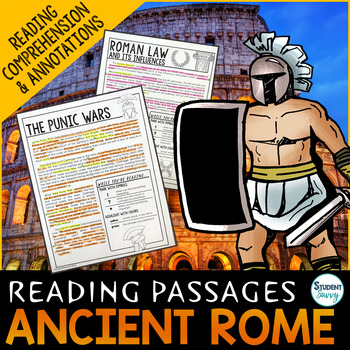Ancient Rome Reading Passages Comprehension Questions Annotations Roman Empire
- PDF
- Easel Activity
What educators are saying
Also included in
- Looking for an engaging and rigorous Ancient Civilization Activities and Social Studies Curriculum that covers The Stone Age / Archaeology, Early Humans, Archaeology, Ancient Mesopotamia, Ancient Egypt, Israel, Ancient India, Ancient China, Ancient Greece, and Ancient Rome, and is both suitable forPrice $175.00Original Price $325.86Save $150.86
- This activity bundle contains 9 resources! Lesson Plan Templates, Curriculum Map, Interactive Notebook Pages, Reading Passages, Interactive PowerPoint, STEM Challenges, Google Classroom Student Projects, Board Game for Review, and Unit Exam**Updates: - 2/22 - 25 Daily Bell RingersPrice $28.00Original Price $41.22Save $13.22
- Ancient Civilizations & World History Reading Comprehension Passages, Worksheets, Questions, and Annotations Bundle! This bundle contains 8 StudentSavvy Reading Passage & Expository Text Resources! It contains a total of 40 Engaging, Non-Fiction Reading Comprehension Passages with DirectionPrice $33.00Original Price $42.00Save $9.00
- ALL of the Reading Comprehension Passages in the StudentSavvy Store! Nonfiction **CURRENTLY 273 Passages!**-Worksheets - Reading Comprehension Passages, Questions, and Annotations--Both Print (PDF) & Digital Options (either in Google Slides or Easel by TpT) It contains Engaging, Non-Fiction ReadPrice $195.00Original Price $302.21Save $107.21
Description
Ancient Rome Worksheets - Reading Comprehension Passages, Questions, and Annotations
This resource is designed for an Ancient Rome unit. It contains 5 Engaging, Non-Fiction Reading Comprehension Passages with Directions for Student Annotations! Reading Comprehension Questions also included!
Questions & Answer Keys for Each of the 5 Reading Passages!
COMMON CORE ALIGNED! Aligned with Ancient Rome - Interactive Notebook
Quick overview of topics covered in this resource include:
1.) The Roman Republic & Daily Life
-Built on seven hills - Latins first came 1,000 BC, Rome was founded in 753 BC and became a Republic in 509 BC
-describes influences (Greeks and Etruscans)
-excelled with military and rose to power
-describes how they were able to maintain control and rule Italy
Keywords: Republic, Confederation, Triumvirate (during collapse)
2.) The Social Hierarchy of Ancient Rome -Describes the hierarchy (Senators, Nobles & Patricians, Plebeians, Freedmen, and Slaves), including the two chief executive officers in Roman Republic (Consuls, Praetors)
Keywords: plebeians, consuls, praetors
3.) Roman Law and Its Influences -Overview of system of government and laws
-describes how their ideas about laws and government influences our legal system today.
Keywords: Twelve Tables, Law of Nations, Roman Constitution, checks and balances
4.) The Punic Wars
-Overview of the First, Second, and Third Punic Wars
-Describes Hannibal Barca of Carthage and what made him an effective leader (great military strategist of all time, crossing of the Alps, the creativity of using war elephants)
Keywords: Punic Wars
5.) The Roman Empire -Describes how it was a period of great growth, wealth and trade (however, there was still an enormous disparity between rich and poor.)
-Describes daily life, entertainment, expansion, economy
Keyword: Pax Romana
You may also enjoy:
Ancient Civilizations (Entire) Curriculum
Ancient Civilizations Interactive Notebook BUNDLE
Ancient Rome Interactive Notebook
Ancient Greece Interactive Notebook
Ancient China - Interactive Notebook
Ancient China - STEM Challenges
Ancient Israel - STEM Challenge
Ancient India - Interactive Notebook
Ancient Mesopotamia - Interactive Notebook
Ancient Egypt - Interactive Notebook
Ancient Israel Unit - Interactive Notebook
__________________________________________________________________
Tips for Savvy TpT Shoppers:
How to receive credit on TpT to use for future purchases:
• Go to your My Purchases page. Under each purchase you'll see a Provide Feedback button. Simply click it and you will be taken to a page where you can give a quick rating and leave a short comment for the product. I value your feedback greatly as it helps me determine which products are most valuable for your classroom so I can create more for you.
Be the first to know about my new discounts, FREEBIES, and products:
• Look for a green star near the top of any page within my store and click it to become a follower. You will now be able to see FREEBIES and customized emails from my store!
©2018StudentSavvy
All rights reserved by author. Permission to copy for single classroom use only. Electronic distribution limited to single classroom use only. (unless you purchase the multiple license)
____________________________________________________________










